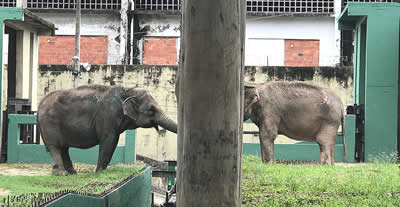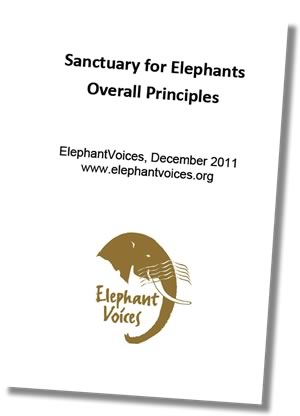INTRODUCTION
Elephants have been held in captivity for various purposes for thousands of years. They are seen by many as a natural resource to be exploited to meet human needs. Elephants are put to work in forestry enterprises, religious institutions, tourism, circuses and zoos, and serve as subjects for captive propagation programs.
 Although elephants are highly adaptable to a broad range of conditions in the wild, they are ill-adapted to captivity. There is now extensive evidence that in captivity elephants suffer from chronic physical and mental ill health often leading to premature death. Research into wild elephant biology has revealed the true range of elephant capabilities and the normal physical and social conditions in which elephants thrive. These conditions are rarely, if ever, met in traditional forms of captivity.
Although elephants are highly adaptable to a broad range of conditions in the wild, they are ill-adapted to captivity. There is now extensive evidence that in captivity elephants suffer from chronic physical and mental ill health often leading to premature death. Research into wild elephant biology has revealed the true range of elephant capabilities and the normal physical and social conditions in which elephants thrive. These conditions are rarely, if ever, met in traditional forms of captivity.
- How best to address the needs of elephants that have already been damaged, or run a significant risk of being so, by traditional captive conditions, but necessarily must remain captive, permanently, or for a period of time?
- How best to devise and manage "sanctuary" - truly safe places of refuge and comfort - for elephants coming from another form of captivity or from the wild as genuine orphans?
THE PURPOSE OF THIS DOCUMENT
ElephantVoices seeks to promote the protection and kinder treatment of elephants, wherever they may be. A primary goal of ElephantVoices' welfare work is to provide a touchstone for anyone needing to address the interests of elephants.
 ElephantVoices is frequently engaged with people and organisations wanting to provide rescue and sanctuary for elephants, as it relates to our mission and to the principles of The Elephant Charter, of which we are authors and signatories.
ElephantVoices is frequently engaged with people and organisations wanting to provide rescue and sanctuary for elephants, as it relates to our mission and to the principles of The Elephant Charter, of which we are authors and signatories.
Two institutions in the United States, The Elephant Sanctuary (TES) in Tennesse, and Performing Animal Welfare Society (PAWS) in California, have pioneered the concept of sanctuary for captive elephants. They have sought to create conditions in which individual elephants may recover a more naturalistic life in captivity, to the extent that they are capable of doing so given their history. In Brazil ElephantVoices is co-founder of Elephant Sanctuary Brazil - a benchmark sanctuary initiative established in 2016 with partner Global Sanctuary for Elephants as a key resource. Furthermore, there are a few institutions in elephant range states that provide refuge for elephants suffering the effects of long captivity. Others raise elephant orphans with the objective of restoring them to a life in the wild. Generally, however, the concept of sanctuary for captive elephants is only beginning to be explored in contexts truly free of traditional and cultural imperatives.
The word "sanctuary" is used in a variety of contexts for a variety of purposes; it may refer to roadside animal shelters, zoos, animal parks or centers, and relatively undisturbed habitat or wildlife refuges. The purpose of this document is to provide the ElephantVoices' view of what sanctuary for captive elephants should mean. In doing so we have sought the comments of many who are engaged in, or are seeking, sanctuary for elephants. We aim to reach anyone interested in ideas about providing sanctuary for captive elephants, but particularly those who seek to directly initiate or assist the development of captive elephant sanctuaries. Accordingly, we focus on the overall principles that we feel are appropriate for any facility or entity hosting elephants under the term "sanctuary".
This document is NOT an endorsement of captivity for elephants and NEITHER is it intended as a general guide to the management of elephants in captivity. We have deliberately avoided making detailed prescriptions for how sanctuary facilities should be designed and managed. Rather, we have set out what we feel are appropriate principles for anyone engaged in such work.
Aligning with the scientific framework of The Elephant Charter, we therefore present here a definition of sanctuary for elephants that:
- Recognizes and reflects the pioneering work of existing elephant sanctuaries.
- Establishes principles to guide the development of new elephant sanctuaries, wherever they may be.
Critical justification for the standpoints in this document regarding the interests and needs of all elephants can be found in The Elephant Charter.
DEFINING SANCTUARY
ElephantVoices holds that the concept of providing sanctuary for elephants involves, first and foremost, a deep understanding and acceptance of the capabilities and the physical, behavioral and psychological needs of elephants. The key to providing sanctuary is always to seek to identify and meet the needs of elephants as individuals. This is as much about a principled approach to engaging with individual elephants, as it is about the design and location of facilities.
ElephantVoices' vision of an elephant sanctuary is, a facility of security and comfort in which a captive elephant can express his or her natural physical, social and cognitive behaviour to the fullest extent possible.
We believe that the mission of any elephant sanctuary should be, to promote and assist the rehabilitation of captive elephants through provision of secure and naturalistic surroundings, social life and individually tailored care programs. The core focus is the physical and psychological wellbeing of individual elephants, both short- and long-term.
ElephantVoices therefore has identified the objectives that we believe any sanctuary should meet, in terms of welfare outcomes for any elephant in care, appreciating that the needs of elephants vary through time and according to their individual histories. These objectives enable us to derive Program Principles for the operation of elephant sanctuaries and, in turn, permit us to draw conclusions about the Physical Aspects - the environment and facilities - that sanctuaries should provide.
OBJECTIVES FOR ELEPHANT SANCTUARIES
ElephantVoices holds that the main objectives of any elephant sanctuary are to provide:
- A management philosophy, facility lay-out and operational procedures based upon the physical, social and cognitive interests of elephants as documented by sound science and laid out in The Elephant Charter.
- A place of refuge that seeks to restore and/or maintain the health and well-being of individual captive elephants.
- Positive, flexible, nurturing care that seeks to fully recognise, understand and account for how the history of each elephant shapes its individual needs.
- Environments and facilities in which individual elephants are helped to reach their fullest potential to lead a naturalistic life, following naturalistic rhythms.
- A primary focus on developing and maintaining positive elephant-elephant social interaction through time.
- Work practices for care givers that are safe, secure and fulfilling, yet follow the rhythms of elephant needs through each 24-hour cycle.
- Facilities that allow for the careful introduction of elephants to each other, the continuous (24-hour) maintenance of social bonds and the careful separation and isolation of individuals when their individual welfare requires.
PROGRAM PRINCIPLES FOR ELEPHANT SANCTUARIES
ElephantVoices holds that elephant sanctuaries shall:
- Have site-specific mission statements that incorporate welfare objectives.
- Receive individual captive elephants or rescued wild orphans, who may need rest-of-life captive-care or who may be returned to the wild at an appropriate time and place.
- Assess the individual needs of each elephant received and anticipate how these needs will change over time.
- Develop a flexible management program for each elephant that accounts for its particular history, from before it is transferred to the sanctuary and until its release to the wild or its death.
- Seek to establish a naturalistic social life for each individual elephant that builds, reinforces and maintains social competence, confidence and resiliency.
- Ensure that all direct interactions between humans and elephants are designed to positively reinforce each elephant in the steps it takes toward a naturalistic life.
- Provide a 24-hour care program for all elephants.
- Deliver medical care as appropriate, with a holistic view of individual elephant health and wellbeing, addressing the underlying problems rather than the symptoms.
- Employ caregivers sensitive to elephant needs, and ensure that training programs in elephant care and behavior are according to the best interest of the elephants.
- Support the health and wellbeing of employees and their families, and recognise their dedication and service.
- Implement site-specific codes of practice, including emergency response practices and practices to ensure elephant and human safety.
- Develop site-specific business plans to support the financial and ecological sustainability of all sanctuary operations.
- Use professionally recognised, legally compliant systems of sustainable human, financial and environmental resource management.
- Use legally established systems of governance.
PHYSICAL ASPECTS OF ELEPHANT SANCTUARIES
ElephantVoices holds that an elephant sanctuary:
- Is a facility designed to meet the changing needs of individual captive elephants over time.
- Is a facility secured by appropriately constructed strong non-injurious barriers from the ingress of uninvited people and animals and the egress of elephants that ensure the safety and comfort of elephants and people.
- Is located in a climate where elephants can remain comfortable out of doors, except in the event of extreme weather, throughout the year.
- Encompasses areas of varied landscape that simulate natural elephant habitats in terms of topography and vegetation cover.
- Encompasses areas sufficiently and appropriately varied to afford healthy elephants with mental and physical stimulation throughout each 24-hour cycle, according to natural rhythms indicated by wild elephant biology.
- Encompasses a sufficient area to allow for a healthy elephant to obtain appropriate levels of physical exercise in pursuing food, water and social activity, throughout each 24-hour cycle without direct human mediation.
- Encompasses sufficient habitat to permit the elephant inhabitants to obtain the majority of their nutritional intake from naturalistic foraging.
- Provides elephants with a choice of shelter from extremes of climate and weather at all times.
- Provides for securing individuals and groups of elephants in facilities that allow the safe introduction of individuals to each other and to groups; the safe introduction of groups to each other; the provision of medical treatment; and the isolation of individuals and groups for quarantine purposes.
- Includes secure, safe, comfortable spaces, facilities and devices for the caregivers to deliver food, water, medical treatment and specific targeted elephant training that may be required to assist in rehabilitation.
- Includes safe and secure facilities for the storage of supplemental elephant food and maintenance equipment.
- Includes safe and secure facilities for the management of animal records and other administrative functions associated with operating the sanctuary.
- Includes provision for heavy vehicle access to targeted points for targeted purposes.
- Makes any provisions for guests secondary to the needs of the elephants, avoiding all potential conflict between elephant wellbeing and visitor safety.


